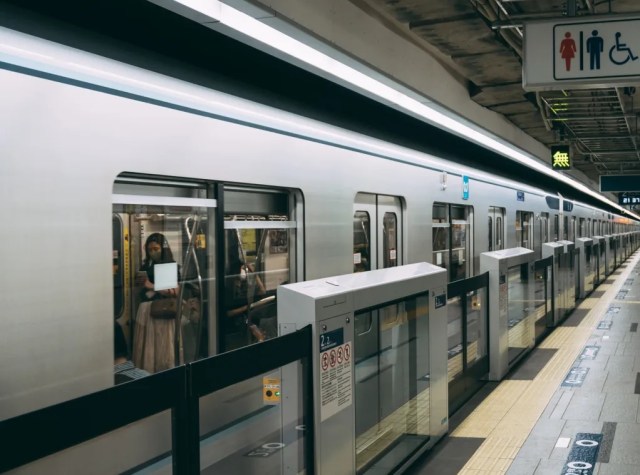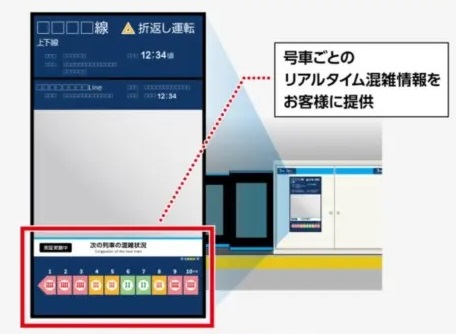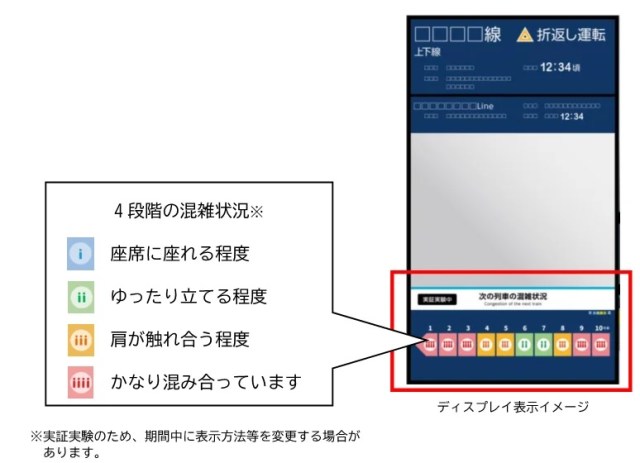
Test program could help Tokyo commuters go from crazy crowded commutes to simply very crowded commutes.
At rush hour, you can pretty much expect every subway train in downtown Tokyo to be crowded. Even on a crowded train, though, not every car is going to be equally crowded.
Wouldn’t it be more comfortable for everyone to spread out as much as possible, resulting in an even distribution of people between the cars? Sure, but there’s more to it than that. Some people might be riding in a certain car because when the train stops at their destination, that car is the closest one to the exit they plan to take. Or maybe an especially large number of people happened to hop into the same section of the train at a particular station, and that car is now too crowded for them to squirm their way to a different one.
So all else equal, if you’re standing on the platform waiting for a train, ideally you want to know where the least crowded cars are going to be, so you can get on the train there. Luckily, there’s a way to do just that, thanks to a new notification system from Tokyo Metro.
A number of Tokyo Metro stations now have automated platform gates with video display screens on them. All that Tokyo Metro needs to do is use those screens to show how crowded each of the cars are on the next arriving train, so that the people who’ll be getting on can pick the least crowded ones.
The display uses a four-level color-coded scale, starting with blue (car has empty seats) and progressing to green (no empty seats, but relatively uncrowded), orange (standing only, shoulders will be in contact with others’), and red (very crowded).
To do all that, Tokyo Metro will use platform-mounted depth-sensing cameras to perform a visual check of the train and feed that information to an A.I. program, which calculates the crowdedness rating and passes the result on to the display at the next station. The company will also be using passenger survey responses to help with fine-tuning.
Congestion displays went into service on Wednesday at Waseda Station on the Tozai Line, specifically on the platform for eastbound trains, as part of a test program. It’s a smart choice for a test site. The stop before Waseda is Takadanobaba Station, a transfer station that connects to both the Yamanote downtown loop train line and the Seibu Shinjuku train line which links downtown Tokyo and residential neighborhoods to the west, as does the Tozai Line itself. Every weekday morning Tozai trains headed east are packed with students on their way to Waseda University and office workers who’ll continue farther down the line to Tokyo’s financial district, so anything that can make commutes smoother would be a plus.
The test will continue until the end of March, traditionally the end of the business year in Japan, and if it works well we might be seeing crowdedness displays on other Tokyo Metro platforms in the near future.
Source: PR Times
Top image: Pakutaso
Insert images: PR Times
● Want to hear about SoraNews24’s latest articles as soon as they’re published? Follow us on Facebook and Twitter!
Follow Casey on Twitter, where he used to start every day with a packed Takadanobaba-to-Waseda subway ride.



 These are the 11 most crowded trains in Japan…and surprise! They’re all in the Tokyo area
These are the 11 most crowded trains in Japan…and surprise! They’re all in the Tokyo area Filled to bursting point? Rush-hour crush on Tokyo subway leaves train with broken window
Filled to bursting point? Rush-hour crush on Tokyo subway leaves train with broken window Tokyo subway bribes people with free noodles to get them to take earlier, non-rush hour trains
Tokyo subway bribes people with free noodles to get them to take earlier, non-rush hour trains Commuter chaos at Shibuya Station after glass window breaks on door of crowded Japanese train
Commuter chaos at Shibuya Station after glass window breaks on door of crowded Japanese train What are Tokyo trains at rush hour really like? Check out our eyewitness account!【Video】
What are Tokyo trains at rush hour really like? Check out our eyewitness account!【Video】 Disillusionment at Tsukiji’s tourist-target prices led us to a great ramen restaurant in Tokyo
Disillusionment at Tsukiji’s tourist-target prices led us to a great ramen restaurant in Tokyo More Than a Capsule Stay: Why Solo Travelers Choose “global cabin Yokohama Chinatown”
More Than a Capsule Stay: Why Solo Travelers Choose “global cabin Yokohama Chinatown” Japan may add Japanese language proficiency, lifestyle classes to permanent foreign resident requirements
Japan may add Japanese language proficiency, lifestyle classes to permanent foreign resident requirements Why you shouldn’t call this food “Hiroshimayaki” if you’re talking to people from Hiroshima
Why you shouldn’t call this food “Hiroshimayaki” if you’re talking to people from Hiroshima Starbucks Japan releases new zodiac chilled cup drink for 2026
Starbucks Japan releases new zodiac chilled cup drink for 2026 Drunk cycling can result in an instantly suspended driver’s license in Japan
Drunk cycling can result in an instantly suspended driver’s license in Japan Naruto ninja village theme park area, Kyubi coaster being added to Parc Spirou Provence【Pics】
Naruto ninja village theme park area, Kyubi coaster being added to Parc Spirou Provence【Pics】 Ultra-premium matcha, koji rice mold star in Starbucks Japanese New Year’s Frappuccino and drinks
Ultra-premium matcha, koji rice mold star in Starbucks Japanese New Year’s Frappuccino and drinks 7-Eleven Japan starts new temporary luggage storage service in over 300 branches
7-Eleven Japan starts new temporary luggage storage service in over 300 branches Is this the most relaxing Starbucks in Japan?
Is this the most relaxing Starbucks in Japan? Starbucks teams up with 166-year-old Kyoto doll maker for Year of the Horse decorations【Photos】
Starbucks teams up with 166-year-old Kyoto doll maker for Year of the Horse decorations【Photos】 Tokyo’s Tsukiji sushi neighborhood asks tour groups to stay away for the rest of the month
Tokyo’s Tsukiji sushi neighborhood asks tour groups to stay away for the rest of the month Street Fighter Hadouken Churros to be launched and eaten in Tokyo, Okami pudding on offer too
Street Fighter Hadouken Churros to be launched and eaten in Tokyo, Okami pudding on offer too Japanese avoiding domestic travel as foreign tourists increase, possibly creating vicious cycle
Japanese avoiding domestic travel as foreign tourists increase, possibly creating vicious cycle Japanese woman mistaken for bear
Japanese woman mistaken for bear Return of Totoro sequel short anime announced for Ghibli Park
Return of Totoro sequel short anime announced for Ghibli Park Starbucks on a Shinkansen bullet train platform: 6 tips for using the automated store in Japan
Starbucks on a Shinkansen bullet train platform: 6 tips for using the automated store in Japan More Shinkansen trains being added to Japan’s “golden route” to meet traveler demand
More Shinkansen trains being added to Japan’s “golden route” to meet traveler demand Japan’s human washing machines will go on sale to general public, demos to be held in Tokyo
Japan’s human washing machines will go on sale to general public, demos to be held in Tokyo Starbucks Japan unveils new Christmas goods and a rhinestone tumbler that costs 19,500 yen
Starbucks Japan unveils new Christmas goods and a rhinestone tumbler that costs 19,500 yen Japanese train company is letting fans buy its actual ticket gates for their homes
Japanese train company is letting fans buy its actual ticket gates for their homes Is China’s don’t-go-to-Japan warning affecting tourist crowds in Tokyo’s Asakusa neighborhood?
Is China’s don’t-go-to-Japan warning affecting tourist crowds in Tokyo’s Asakusa neighborhood? The 10 best day trips from downtown Tokyo【Survey】
The 10 best day trips from downtown Tokyo【Survey】 Tokyo considering law requiring more trash cans following litter increase in heavily touristed area
Tokyo considering law requiring more trash cans following litter increase in heavily touristed area Nintendo’s Kirby now delivering orders at Kura Sushi restaurants, but not in Japan
Nintendo’s Kirby now delivering orders at Kura Sushi restaurants, but not in Japan Survey asks foreign tourists what bothered them in Japan, more than half gave same answer
Survey asks foreign tourists what bothered them in Japan, more than half gave same answer Japan’s deadliest food claims more victims, but why do people keep eating it for New Year’s?
Japan’s deadliest food claims more victims, but why do people keep eating it for New Year’s? We deeply regret going into this tunnel on our walk in the mountains of Japan
We deeply regret going into this tunnel on our walk in the mountains of Japan Studio Ghibli releases Kodama forest spirits from Princess Mononoke to light up your home
Studio Ghibli releases Kodama forest spirits from Princess Mononoke to light up your home Major Japanese hotel chain says reservations via overseas booking sites may not be valid
Major Japanese hotel chain says reservations via overseas booking sites may not be valid Put sesame oil in your coffee? Japanese maker says it’s the best way to start your day【Taste test】
Put sesame oil in your coffee? Japanese maker says it’s the best way to start your day【Taste test】 The top 10 annoying foreign tourist behaviors on trains, as chosen by Japanese people【Survey】
The top 10 annoying foreign tourist behaviors on trains, as chosen by Japanese people【Survey】 No more using real katana for tourism activities, Japan’s National Police Agency says
No more using real katana for tourism activities, Japan’s National Police Agency says Starbucks Japan reveals new sakura drinkware collection, inspired by evening cherry blossoms
Starbucks Japan reveals new sakura drinkware collection, inspired by evening cherry blossoms New Year’s Eve plans in Tokyo? Tokyo Metro won’t be running any extra late-night trains this year
New Year’s Eve plans in Tokyo? Tokyo Metro won’t be running any extra late-night trains this year One passenger pusher isn’t enough for Tokyo area train that needs three-man team【Video】
One passenger pusher isn’t enough for Tokyo area train that needs three-man team【Video】 One of Tokyo’s most useful subway lines for travelers is about to get more convenient
One of Tokyo’s most useful subway lines for travelers is about to get more convenient Tokyo Metro to begin playing classical background music on Hibiya Line trains
Tokyo Metro to begin playing classical background music on Hibiya Line trains Hypnotic moving map of Tokyo’s crazy rush hour trains almost makes them relaxing【Video】
Hypnotic moving map of Tokyo’s crazy rush hour trains almost makes them relaxing【Video】 Taste the floor of a Japanese train station with new limited-edition chocolates from Tokyo Metro
Taste the floor of a Japanese train station with new limited-edition chocolates from Tokyo Metro Venture through the Tokyo Metro Network to complete the Ghibli Quiz Rally!
Venture through the Tokyo Metro Network to complete the Ghibli Quiz Rally! November snow falls in Tokyo for first time in 54 years, causes chaos for peak hour commuters
November snow falls in Tokyo for first time in 54 years, causes chaos for peak hour commuters Can you guess where this amazing Japanese commuter train is hiding some extra seats? 【Video】
Can you guess where this amazing Japanese commuter train is hiding some extra seats? 【Video】 JR, Tokyo Metro, other rails lines adding discounts for mentally handicapped riders, caregivers
JR, Tokyo Metro, other rails lines adding discounts for mentally handicapped riders, caregivers Can you spot the problem with this Tokyo subway sign in this tale of awesome customer service?
Can you spot the problem with this Tokyo subway sign in this tale of awesome customer service? Rush hour trains in London are worse than Tokyo, according to our Japanese-language reporter
Rush hour trains in London are worse than Tokyo, according to our Japanese-language reporter What are you supposed to do with your backpack on a crowded train in Japan?
What are you supposed to do with your backpack on a crowded train in Japan? Stay in a special Tokyo Metro train room at a hotel with a front seat to the railways
Stay in a special Tokyo Metro train room at a hotel with a front seat to the railways
Leave a Reply